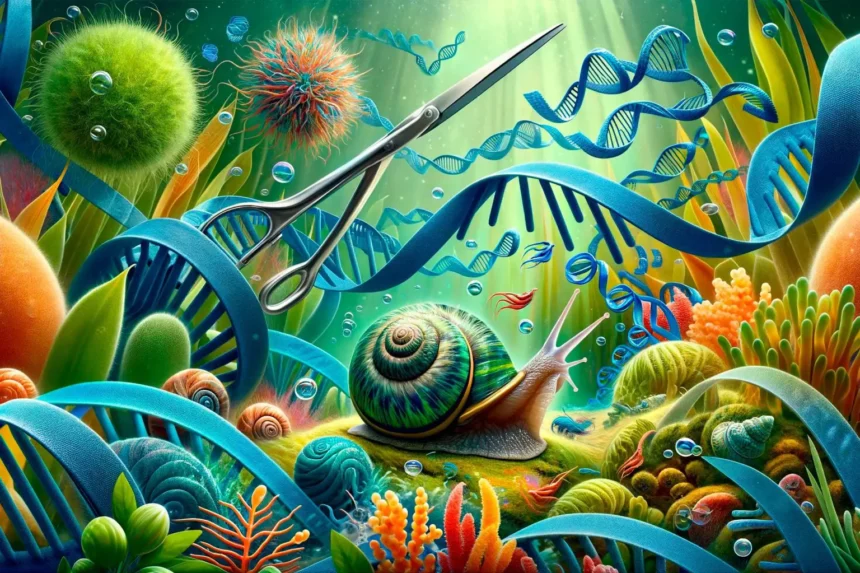CRISPR is a revolutionary gene editing technology that has transformed the field of synthetic biology. CRISPR allows scientists to easily and precisely modify the DNA of any organism, opening up new possibilities for research and medicine. However, CRISPR is not the only game in town when it comes to programmable DNA-cutting enzymes. A recent study from MIT’s McGovern Institute for Brain Research has revealed that thousands of such enzymes exist in nature, hidden in the genomes of algae, snails, and other eukaryotic organisms1.
What are Fanzors?: CRISPR
The newly discovered enzymes are called Fanzors, which stands for FANCD2/FANCI-associated nuclease domains2. Fanzors are RNA-guided enzymes that can be programmed to cut DNA at specific sites, much like the bacterial enzymes that power CRISPR. Fanzors are part of a larger family of proteins called FANCD2/FANCI, which are involved in DNA repair and genome stability2. FANCD2/FANCI proteins are found in almost all eukaryotic organisms, from yeast to humans, and mutations in them can cause a rare genetic disorder called Fanconi anemia3.

Also read : How Can We Differentiate So Many Different Foods If We Can Only Taste Four Flavors On Our Tongue
Fanzors were first identified by McGovern investigator Feng Zhang and his colleagues earlier this year, when they discovered a Fanzor enzyme in a freshwater algae called Chlamydomonas reinhardtii2. They showed that this Fanzor enzyme, named CrFAN1, could be engineered to cut specific DNA sequences in human cells, demonstrating its potential as a gene editing tool2. However, the researchers suspected that CrFAN1 was not the only Fanzor enzyme in nature, and set out to find more.
How did they find them?
To search for more Fanzor enzymes, the researchers used a computational approach called homology-based search, which looks for similar sequences of amino acids in different proteins. They scanned the genomes of over 1,000 eukaryotic organisms, ranging from plants to animals to fungi, and found more than 10,000 Fanzor candidates1. They then validated some of these candidates experimentally, and confirmed that they indeed had RNA-guided DNA-cutting activity1.

The researchers found that Fanzors are widespread and diverse among eukaryotic organisms, and that they have evolved independently multiple times in different lineages1. They also found that Fanzors have different features and preferences than CRISPR enzymes, such as the length and composition of their guide RNAs, the location and orientation of their DNA targets, and the type and frequency of their DNA cuts1. These differences could make Fanzors more suitable or versatile for certain applications than CRISPR.
Why do they matter?
The discovery of Fanzors opens a new frontier of RNA-guided biology, and expands the toolbox of gene editing tools available for scientists. Fanzors could offer some advantages over CRISPR, such as being less toxic, more efficient, or more specific in certain contexts1. Fanzors could also enable new types of experiments that are not possible with CRISPR, such as creating large libraries of mutations, screening for gene function, or studying genome evolution1.

Moreover, Fanzors could help shed light on the origin and evolution of RNA-guided biology, and the role of FANCD2/FANCI proteins in eukaryotic organisms. Fanzors could reveal how eukaryotic cells use RNA-guided enzymes to manipulate their own DNA, and how they balance the need for DNA repair and genome stability with the potential for genetic diversity and adaptation1.
What’s next?
The researchers plan to continue exploring the diversity and function of Fanzor enzymes, and to develop them into new tools for research or medicine. They also hope to collaborate with other scientists to apply Fanzor technology to various biological questions and challenges. By doing so, they hope to unleash the hidden gene editing superpowers of algae, snails, and other organisms.
Conclusion: Nature’s Unveiling Secrets
The discovery of gene-editing superpowers hidden within algae and snails not only captures the imagination of scientists but also redefines our perception of the capabilities inherent in the natural world. As we explore and harness these newfound genetic editing tools, we embark on a journey that transcends the boundaries of what we thought was possible, proving once again that nature holds the keys to unlocking the mysteries of our genetic code. The era of natural gene editors has dawned, inviting us to peer into the intricate dance of genes and envision a future where the boundaries between technology and nature blur in the pursuit of scientific innovation.
Also read : Heart’s Herculean Task: Defying Gravity To Pump Life Upward




































